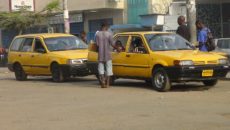It’s 10:30 a.m., May 14, 2017: A late model Toyota Corolla traveling from Gbarnga towards Ganta approaches the St. John River Bridge. It has a flat tire. The driver slows down and pulls over. He and his four passengers get out, and between them, they place some grass and branches on the road to warn oncoming traffic and change the wheel. Twenty minutes later, they’re on their way again and in less than 30 minutes more of smooth motoring on the new highway, they’re in Ganta.
10:30 a.m., May 14, 2017: A late model Toyota Corolla speeding from Gbarnga towards Ganta approaches the St. John River Bridge, at which point the tire bursts. The driver loses control. The car skids into the ditch on the right, hits the earth embankment head-on, activating the airbags. The car then bounces across the road and into the ditch on the other side where it hits the embankment going backward and comes to a stop. The driver and passengers look at each other, a little shaken, remove their seatbelts, and force the doors open. They all breathe a sigh of relief and flag down the next passing taxi.
10:30 a.m., May 14, 2017: A late model Toyota Corolla speeding from Gbarnga towards Ganta approaches the St. John River Bridge, at which point the tire bursts. The driver loses control. The car skids into the ditch on the right, hits the earth embankment head-on, activating the airbags. It bounces across the road and into the ditch on the other side where it hits the embankment going backward and comes to a rest. Three injured passengers are pulled from the car by other travelers who have stopped. The other two passengers are dead.
Any of these three scenarios could have happened, but only one did: unfortunately, it was the third.
We do not know for sure exactly why this accident had such tragic consequences. What we do know is that speed influences a driver’s ability to control a car which has a flat tire, a blowout, or “tire fire.†Other important factors include the driver’s experience, whether he has been drinking or using drugs, and the mechanical condition of the vehicle. We also know that in modern cars, which have crumple zones and airbags, even relatively high-speed crashes are usually survivable if everyone wears their seatbelt.
What could have been a relatively minor inconvenience became a tragedy for quite trivial reasons.
The road between Gbarnga and Ganta is new and in excellent condition and will be maintained this way by the contractor that built it for at least the next seven years. My job is to monitor this contractor’s performance in this task.
Part of the contractor’s duties is to remove wrecked vehicles, debris, and spills which result from traffic accidents, keeping the road open and safe. They also repair any damaged items, including signs, guardrails, and the road surface.
They’ve been doing this on the completed road for just over a year now, so we have seen a few accidents. There were 28 accidents which required repair work by the contractor between March 2016 and February 2017 on this 70 km stretch of highway.
It cost the government almost US$40,000 just to clean up and repair the damage. We do not know how many more accidents there were that did not require repairs to the road. In these 28 accidents, four people were reported as being dead at the scene. More were severely injured and possibly succumbed to these injuries after leaving the scene.
What I am seeing on the road is that the vast majority of accidents we are responding to are a result of a tire blowout. The condition of tires on many vehicles plying this route, including and maybe especially commercial taxis, is almost beyond belief.
It is certainly not surprising that blowouts are so frequent. The recent fatal accident I described above was due to a blowout. When I inspected the wreck, the tire was worn down to the wire braiding.
As part of my job, I carry out regular inspections of this section of road. During these inspections, I often come across broken down vehicles. Some are being repaired right there by the side of the road, spilling oil, fuel, and other corrosive fluids onto the road.
The contractor cleans up these as well, not only to ensure motorbikes and other vehicles do not skid on them, but also to prevent them from weakening the road surface. I also see vehicles where wheels have fallen off. This damages the road when the wheel hub or brake digs into the road. However, it is what I see when the wheel is removed which truly frightens me. On more than one occasion, there has been no brake mechanism on the wheel.
Deaths, injuries, and damage to this vital main road can be prevented with some care and attention from drivers. Your passengers and fellow citizens are counting on you to be safe and responsible.
- Wear Seatbelts
- Don’t drive on bald or worn-out tires. Tires should have some tread pattern over the full width.
- Don’t speed or drive when tired or drunk or use your phone while driving.
- Keep your vehicle in safe working condition, with special attention to brakes, and lights… please.
Featured photo courtesy of the Vehicles of Liberia Facebook page



